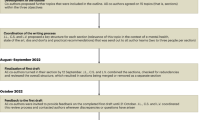Abstract
It is often difficult for health providers to evaluate available e-mental health products because of the need to balance between obtaining reliable evidence of efficacy and the burdens associated with standard empirical evaluation. This paper makes the case for using a feasible method to investigate available e-mental health programs in order to promote knowledge and increase the uptake of e-mental health products.
Similar content being viewed by others
References
Aitken, M., & Gauntlett, C. (2013). Patient apps for improved healthcare: From novelty to mainstream. Parsippany. NJ: IMS Institute for Healthcare Informatics.
Babin, B. J., & Griffin, M. (1998). The nature of satisfaction: An updated examination and analysis. Journal of Business Research, 41(2), 127–136.
Bakker, D., Kazantzis, N., Rickwood, D., & Rickard, N. (2016). Mental health smartphone apps: Review and evidence-based recommendations for future developments. JMIR mental health, 3(1), e7. doi:10.2196/mental.4984.
Baumel, A., Correll, C. U., & Birnbaum, M. (2016). Adaptation of a peer based online emotional support program as an adjunct to treatment for people with schizophrenia-spectrum disorders. Internet Interventions, 4, 35–42. doi:10.1016/j.invent.2016.03.003.
Baumel, A., & Muench, F. (2016). Heuristic evaluation of Ehealth interventions: Establishing standards that relate to the therapeutic process perspective. JMIR Mental Health, 3(1), e5. doi:10.2196/mental.4563.
Baumel, A., & Schueller, S. M. (2016). Adjusting an available online peer support platform in a program to supplement the treatment of perinatal depression and anxiety. JMIR Mental Health, 3(1), e11. doi:10.2196/mental.5335.
Ben-Zeev, D., Kaiser, S. M., Brenner, C. J., Begale, M., Duffecy, J., & Mohr, D. C. (2013). Development and usability testing of FOCUS: A smartphone system for self-management of schizophrenia. Psychiatric Rehabilitation Journal, 36(4), 289–296. doi:10.1037/prj0000019.
Boudreaux, E. D., Waring, M. E., Hayes, R. B., Sadasivam, R. S., Mullen, S., & Pagoto, S. (2014). Evaluating and selecting mobile health apps: strategies for healthcare providers and healthcare organizations. Translational Behavioral Medicine, 4(4), 363–371. doi:10.1007/s13142-014-0293-9.
Christensen, H., Griffiths, K. M., & Farrer, L. (2009). Adherence in internet interventions for anxiety and depression: A systematic review. Journal of Medical Internet Research, 11(2), e13.
Christensen, H., & Mackinnon, A. (2006). The law of attrition revisited. Journal of Medical Internet Research, 8(3), e20.
Currie, S. L., McGrath, P. J., & Day, V. (2010). Development and usability of an online CBT program for symptoms of moderate depression, anxiety, and stress in post-secondary students. Computers in Human Behavior, 26(6), 1419–1426.
Davis, F. D. (1989). Perceived usefulness, perceived ease of use and user acceptance of information technology. MIS Quarterly, 13, 319–340.
Eysenbach, G. (2001). What is e-health?. Journal of Medical Internet Research, 3(2), e20. http://doi.org/10.2196/jmir.3.2.e20.
Eysenbach, G. (2005). The law of attrition. Journal of Medical Internet Research, 7(1), e11. doi:10.2196/jmir.7.1.e11.
Karat, C. (1994). Comparison of user interface evaluation methods. In J. Nielsen & R. L. Mack (Eds.), Usability inspection methods (pp. 203–233). New York, NY: John Wiley & Sons.
Kotronoulas, G., Kearney, N., Maguire, R., Harrow, A., Di Domenico, D., Croy, S., & MacGillivray, S. (2014). What is the value of the routine use of patient-reported outcome measures toward improvement of patient outcomes, processes of care, and health service outcomes in cancer care? A systematic review of controlled trials. Journal of Clinical Oncology, 32(14), 1480–1501.
Kumar, S., Nilsen, W. J., Abernethy, A., Atienza, A., Patrick, K., Pavel, M. et al. (2013). Mobile health technology evaluation: The mHealth evidence workshop. American Journal of Preventive Medicine, 45(2), 228–236. doi:10.1016/j.amepre.2013.03.017.
Lund, A. M. (2001). Measuring usability with the USE questionnaire. Usability Interface, 8(2), 3–6.
Madan, A., & Dubey, S. K. (2012). Usability evaluation methods: A literature review. International Journal of Engineering Science and Technology, 4(2), 590–599.
McEnzie, N. (1995). Computerised clinical benefit-cost audit of mental health care II: Time input, costs, patient satisfaction. Journal of Mental Health, 4(1), 71–78.
Mohr, D. C., Schueller, S. M., Riley, W. T., Brown, C. H., Cuijpers, P., Duan, N., … Cheung, K. (2015). Trials of intervention principles: Evaluation methods for evolving behavioral intervention technologies. Journal of Medical Internet Research, 17(7), e166. doi:10.2196/jmir.4391.
PsyberGuide Website. http://psyberguide.org/. Accessed 10 April 2015. Archived by WebCite® at http://www.webcitation.org/6Xh99eQmZ.
Reja, U., Manfreda, K. L., Hlebec, V., & Vehovar, V. (2003). Open-ended vs. close-ended questions in web questionnaires. Developments in Applied Statistics, 19, 159–177.
Snyder, C. F., Aaronson, N. K., Choucair, A. K., Elliott, T. E., Greenhalgh, J., Halyard, M. Y., et al. (2012). Implementing patient-reported outcomes assessment in clinical practice: A review of the options and considerations. Quality of Life Research, 21(8), 1305–1314. doi:10.1007/s11136-011-0054-x.
Stoyanov, S. R., Hides, L., Kavanagh, D. J., Zelenko, O., Tjondronegoro, D., & Mani, M. (2015). Mobile app rating scale: A new tool for assessing the quality of health mobile apps. JMIR mHealth and uHealth, 3(1). doi:10.2196/mhealth.3422.
Twomey, C., O’Reilly, G., Byrne, M., Bury, M., White, A., Kissane, S., et al. (2014). A randomized controlled trial of the computerized CBT programme, MoodGYM, for public mental health service users waiting for interventions. British Journal of Clinical Psychology, 53(4), 433–450. doi:10.1111/bjc.12055.
Author information
Authors and Affiliations
Corresponding author
Appendix: A Survey Aimed at Eliciting Participants’ Feedback Following Product Demonstration
Appendix: A Survey Aimed at Eliciting Participants’ Feedback Following Product Demonstration
Open-Ended Questions
How would you describe your experience of using this program?
How might the program be made better?
How do you believe this program could complement ongoing treatment?
Closed-Ended Questions (Responses Rated on a Likert Scale)
Usability
I found the program to be accessible and easy to use.
Usefulness
I liked using this service.
I can see how after a certain amount of time using the program people would feel better.
Intention to Use and Recommend
I would like to use this program.
I would recommend this program to people who suffer from my condition.
Rights and permissions
About this article
Cite this article
Baumel, A. Making the Case for a Feasible Evaluation Method of Available E-Mental Health Products. Adm Policy Ment Health 45, 1–4 (2018). https://doi.org/10.1007/s10488-016-0764-z
Published:
Issue Date:
DOI: https://doi.org/10.1007/s10488-016-0764-z




